TO
| Title | Date | Subject | Description | ||
|---|---|---|---|---|---|
| 1 |
 |
UPED index to parameters and exogenous variables data sources and calibration procedures | |||
| 2 |
 |
Utah economic and demographic profiles | 1988-08 | Data users in the public and private sectors frequently are in need of economic and demographic information about the State of Utah. More often than not, however, the needed data is found in numerous government reports, located at several different places, for variousy ears. This report, Utah Econom... | |
| 3 |
 |
Directory of State of Utah statistics 1971 | 1971-09 | The Directory of State of Utah Statistics has been developed in response to the need for a fairly comprehensive guide to statistical information published by the State. The Directory is intended to fulfill two objectives. The first and major objective is to make available to policy makers, planners ... | |
| 4 |
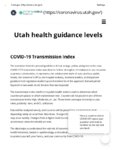 |
Utah health guidance levels | COVID-19; transmission | Snapshot of the county-by-county transmission levels of COVID-19 | |
| 5 |
 |
Vol 32 No 1 | |||
| 6 |
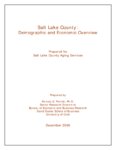 |
Salt Lake County: demographic and economic overview | 2006-12 | Salt Lake County; Utah; Demographics; Aging; Dependency ratio; Foreign born; Immigrants; Age structure; Age waves; Occupation; Labor force participation; Sex ratio; Educational attainment; commuting | Salt Lake County is the economic, political, and cultural center of Utah. The county is currently home to nearly 40 percent of Utah residents and generates about half of all jobs in the state. It remains the most populous county, with a million of the state's 2.6 million residents,1 and its daytime ... |
| 7 |
 |
Projections for school population and teacher demand in the State of Utah for the period 1970-2000 | 1975 | This study deals with probable future trends in student enrollment, accoroing to age, sex, grades, and school levels, for different geographic areas, and teacher demand for the elementary and secondary levels of school in Utah from 1970 to the year 2000. For the secondary level schools, information ... | |
| 8 |
 |
Population projections by age and sex for Utah counties 1970-2000 | 1976-12 | Future trends in population must be a factor in guiding long-term socioeconomic planning efforts in order for the planning to be effective. To be realistic, economic and social planning must take into account not only the future size, but also the composition and distribution of the population. ... | |
| 9 |
 |
Part 7 | |||
| 10 |
 |
Part 2 | |||
| 11 |
 |
The Utah process phase II report: preparation for analysis of the alternative futures: development of tools and concepts | 1972-04 | This report presents the final specification of the five Alternative Futures and the method of dealing with the social and political events to the Utah Systems Planning Group and the Utah Systems Work Committee. Both elements are of central importance to the Utah Process since they present the possi... | |
| 12 |
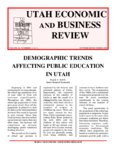 |
Demographic trends affecting public education in Utah | 2000-11 | Beginning in 2004 and continuing for at least a decade, the school age population (5 to 18 year olds) in Utah will increase significantly. Throughout the 1990s, the school age population in Utah grew more slowly than did the population in general so that its share in the total population declined. T... | |
| 13 |
 |
Areawide and local effects of tar sands development at the Sunnyside site in Utah: A socioeconomic analysis | 1984-04 | The Combined Hydrocarbon Leasing Act of 1982 (Public Law 97-78) provides guidelines for converting federal oil and gas leases to combined hydrocarbon leases in Special Tar Sands Areas (STSAs). The STSAs are designated by the U.S. Department of the Interior as areas that contain substantial deposits ... | |
| 14 |
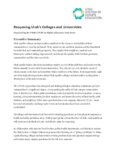 |
Reopening Utah's Colleges and Universities | 2020-05 | COVID-19; USHE; higher ed | Executive summary |
| 15 |
 |
State of Utah economic & demographic projections 1994: highlights | 1994-10 | This document reviews and examines the major conclusions from the larger, more detailed report, State of Utah Economic and Demographic Projections 1994. The Governor's Office of Planning and Budget (GOPB) publishes these long-term projections biennially. The primary purpose of the projections is to ... | |
| 16 |
 |
Vital Statistics and Health | 1973 | ||
| 17 |
 |
Facts in Brief | |||
| 18 |
 |
AB_Facts in Brief | |||
| 19 |
 |
Facts in Brief | |||
| 20 |
 |
Vol 31 No 10 | |||
| 21 |
 |
Utah State preliminary development plan | 1969-03 | The Four Corners Economic Development Region, consisting of a 92-county area in Arizona, Colorado, New Mexico, and Utah, was established December 19, 1966, under Title V of the Public Works and Economic Development Act of 1965. On September 19, 1967 the Four Corners Regional Commission was created ... | |
| 22 |
 |
AQ_Facts in Brief | |||
| 23 |
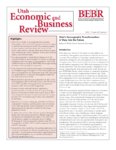 |
Utah's demographic transformation: a view into the future | 2008 | Utah, along with the rest of the nation, is in the midst of an extraordinary demographic transformation which has far from run its course. The confluence of four major trends continues to dramatically reshape the size and composition of the national and state populations. These trends include the ar... | |
| 24 |
 |
QGET quality growth efficiency tools scenario analysis | 1999-03 | The Greater Wasatch Area is currently home to 1.6 million people (a population slightly smaller than the Portland metro area). By 2020, the population is expected to increase to 2.7 million people (a population roughly equivalent in size to the current population of the San Diego metro area). Th... | |
| 25 |
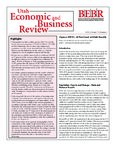 |
Census 2010 - a first look at Utah results | 2011 | Census; 2010; Utah; Demographics; Population; Age; Sex; Race; Ethnicity | Early results from the long-awaited 2010 Census are revealing the outlines of the more detailed portrait that will not be available for at least a couple more years. This essay reviews the top-level population change and geographic distribution results primarily from the redistricting data set.1 We ... |
